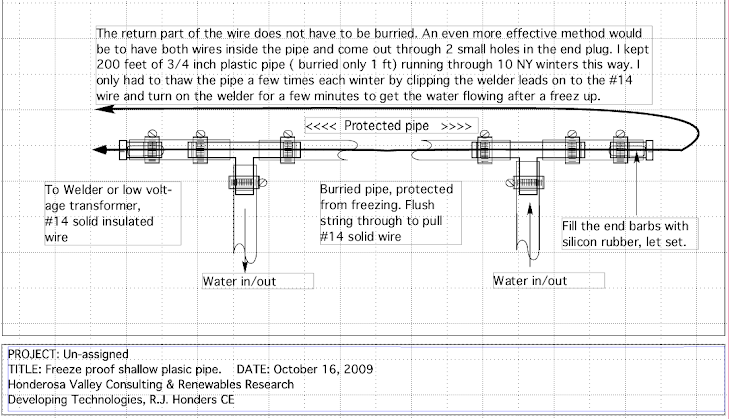

 The slush completely blocks the trash rack and any liquid water runs around the intake. This shot is looking up stream, note the big rock that guides the water directly into the flume. Since there is very little debris in the slushy water I removed both the primary and secondary self cleaning trash racks to keep things flowing. With no metal parts for ice to build up on and attach itself, I was able to keep it flowing down the 550' of 8 inch steel penstock, but only after adding some insulation to the penstock where it could not be buried. This year I added a small (1/2") buried plastic pipe that feeds 45°F water, in winter, from a spring a 1/2 mile away and 150 feet up. This warm water squirts out and upstream from the intake at 1.5 gal/min. We'll see if it helps keep things flowing. I need a dubious emoticon here. It sure can't hurt. I'll report back.
The slush completely blocks the trash rack and any liquid water runs around the intake. This shot is looking up stream, note the big rock that guides the water directly into the flume. Since there is very little debris in the slushy water I removed both the primary and secondary self cleaning trash racks to keep things flowing. With no metal parts for ice to build up on and attach itself, I was able to keep it flowing down the 550' of 8 inch steel penstock, but only after adding some insulation to the penstock where it could not be buried. This year I added a small (1/2") buried plastic pipe that feeds 45°F water, in winter, from a spring a 1/2 mile away and 150 feet up. This warm water squirts out and upstream from the intake at 1.5 gal/min. We'll see if it helps keep things flowing. I need a dubious emoticon here. It sure can't hurt. I'll report back. The insulation I used is only about a quarter inch of foam, ordinarily used to seal between a footing and the sill plate of a building. It comes in 50 ft X 8 inch rolls at building supply depots. To protect the foam I spiral wrapped it with high quality roofing underlayment, and coated that with rubberized roofing compound. To make the spiral wrapping process manageable I cut the 3 ft rolls in half. Start the wrapping at the bottom and overlap a couple of inches so it sheds water. Note the power and control conduits are strapped to the penstock with stainless straps and are included in the insulation.
The insulation I used is only about a quarter inch of foam, ordinarily used to seal between a footing and the sill plate of a building. It comes in 50 ft X 8 inch rolls at building supply depots. To protect the foam I spiral wrapped it with high quality roofing underlayment, and coated that with rubberized roofing compound. To make the spiral wrapping process manageable I cut the 3 ft rolls in half. Start the wrapping at the bottom and overlap a couple of inches so it sheds water. Note the power and control conduits are strapped to the penstock with stainless straps and are included in the insulation. This is a picture of the first year freeze-up being thawed out. The ice covered dam is visible in the distance. This freeze-up probably would not have happened if the water had continued to flow into the flume, but I suspect that the trash rack gradually reduced the water flow to a standstill causing everything to freeze.
This is a picture of the first year freeze-up being thawed out. The ice covered dam is visible in the distance. This freeze-up probably would not have happened if the water had continued to flow into the flume, but I suspect that the trash rack gradually reduced the water flow to a standstill causing everything to freeze. Here is a picture looking down the 200 foot waterfall in winter. There is actually water flowing under there! Note the as yet un-insulated penstock upper left going slightly down hill.
Here is a picture looking down the 200 foot waterfall in winter. There is actually water flowing under there! Note the as yet un-insulated penstock upper left going slightly down hill. This shot shows the (temporary/test) intake box that has baffles and screens to separate the water from gravel, leaves etc. The flume is not yet installed. The gravel dump valve oulet is directly under the '24'. The penstock is right under the '7' and there is an 8 inch butterfly valve stem visible just above the '2'. See the drawing posted for more detail. This intake structure, being successful, will be made more permanent with concrete before the wood disintegrates. I hope it will last a few more seasons as is.
This shot shows the (temporary/test) intake box that has baffles and screens to separate the water from gravel, leaves etc. The flume is not yet installed. The gravel dump valve oulet is directly under the '24'. The penstock is right under the '7' and there is an 8 inch butterfly valve stem visible just above the '2'. See the drawing posted for more detail. This intake structure, being successful, will be made more permanent with concrete before the wood disintegrates. I hope it will last a few more seasons as is.Try this link to a live webcam monitoring the intake, http://powershack.shacknet.nu:1026/
Click on Guest visit. Will have night lighting soon.









No comments:
Post a Comment